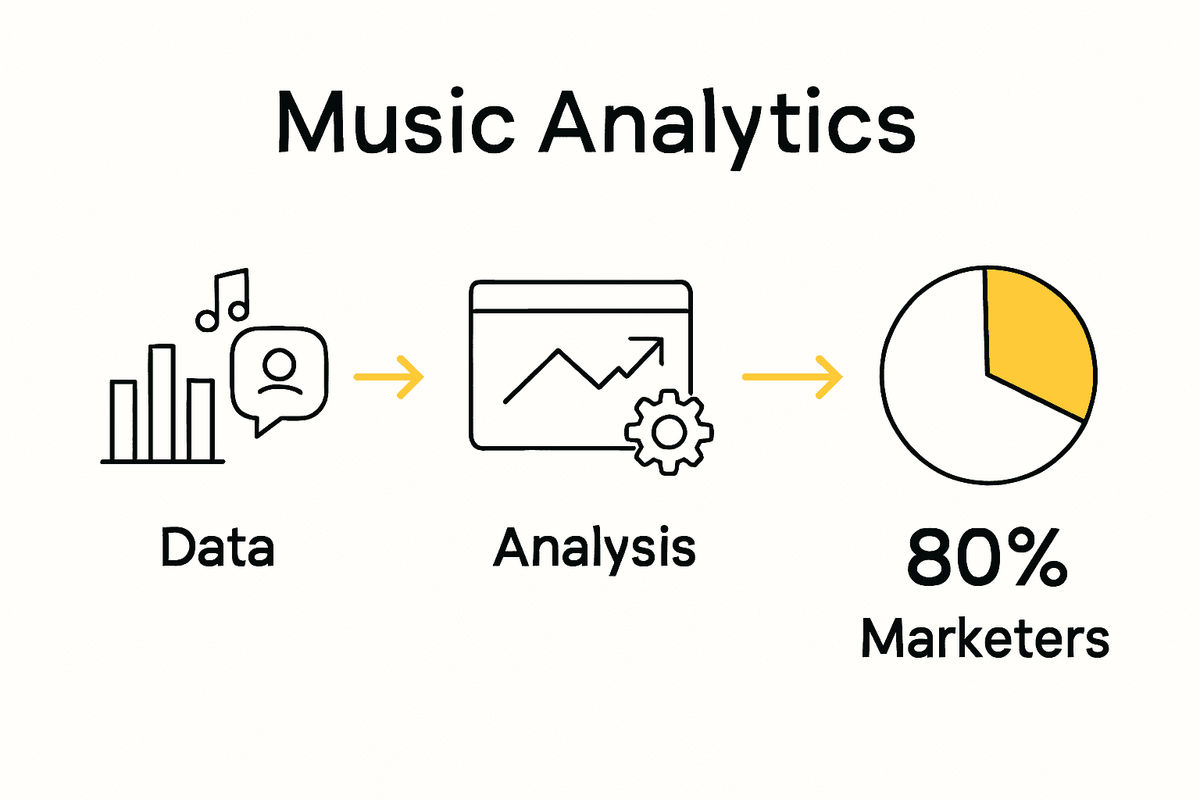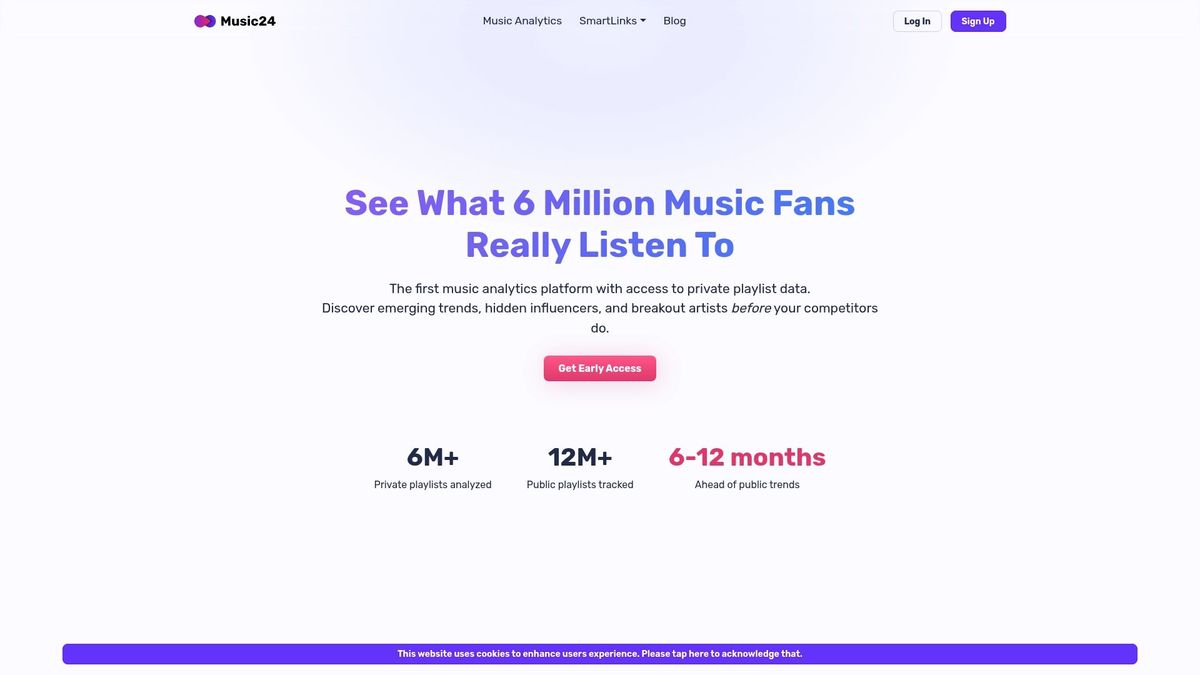Most listeners never realize how much data drives the music they discover. In a world where one viral hit can launch a career overnight, understanding the real impact of analytics on music marketing is more important than ever. Over 80 percent of music marketers now rely on in-depth data insights to shape campaigns and spot new trends. This article connects the dots between raw numbers and creative strategy, showing how data helps artists stand out and reach the right audiences.
Table of Contents
- Defining Data's Role in Music Marketing
- Types of Music Data and Their Sources
- How Playlist Analytics Reveal Emerging Trends
- Leveraging Data for Targeted Artist Promotion
- Risks, Limitations, and Ethical Considerations
Key Takeaways
| Point | Details |
|---|---|
| Data-Driven Strategies | Leveraging music data allows marketers to create precise, evidence-based strategies that enhance audience engagement and artist visibility. |
| Emerging Trends | Utilizing playlist analytics helps in identifying emerging trends and genre-blending patterns that traditional metrics may overlook. |
| Targeted Promotions | Sophisticated data analytics enable hyper-targeted artist promotions by understanding listener demographics and preferences. |
| Ethical Considerations | The music industry must prioritize ethical data practices, ensuring listener privacy and preventing algorithmic biases while utilizing analytics. |
Defining Data's Role in Music Marketing
Data has become the hidden powerhouse transforming how music marketing strategies are developed, executed, and measured. By leveraging insights beyond traditional metrics, music industry professionals can now make precise, strategic decisions that directly impact artist growth and audience engagement. Music marketing data provides an unprecedented window into listener behaviors, preferences, and emerging trends that were previously invisible.
In today's competitive music landscape, data serves multiple critical functions for marketers. These range from audience segmentation to predictive trend analysis, enabling teams to move from intuition-based approaches to evidence-driven strategies. By analyzing granular playlist data, streaming patterns, geographic listener distributions, and cross-genre interactions, marketing teams can craft hyper-targeted campaigns that resonate with specific audience segments.
The core value of data in music marketing lies in its ability to uncover hidden connections and discovery patterns. For instance, understanding music marketing analytics reveals how certain tracks gain momentum through private playlist networks before becoming mainstream hits. Marketing professionals can now track:
- Emerging genre-blending trends
- Micro-geographic listener preferences
- Playlist curator influence networks
- Early-stage artist momentum signals
By embracing data-driven methodologies, music marketers transform from reactive tacticians to proactive strategists who can anticipate and shape audience engagement before traditional metrics catch up. The future of music marketing isn't just about collecting data—it's about translating complex information into actionable, creative strategies that connect artists with their most passionate listeners.
Types of Music Data and Their Sources
Music data has evolved into a complex ecosystem of interconnected information sources that provide unprecedented insights into listener behavior, artist performance, and industry trends. Streaming platform data represents the most dynamic and real-time source of musical intelligence, capturing everything from listener preferences to geographic streaming patterns. As arxiv.org demonstrates through the Free Music Archive dataset, comprehensive audio track collections now offer rich metadata and pre-computed features that transform how we understand music consumption.
The primary types of music data can be categorized into several key domains. Streaming metrics include total plays, skip rates, playlist additions, and listener demographics. Social media engagement data tracks artist mentions, hashtag trends, and viral content spread. Playlist network analysis reveals curator influence, genre-crossing trends, and emerging artist discovery patterns. 7 top music data sources can help professionals navigate this complex landscape effectively.
Advanced music data sources now go beyond traditional metrics. Research from arxiv.org highlights the emerging Music Annotation Pattern, which aims to standardize music annotation systems for more comprehensive data integration. This approach enables more nuanced analysis by creating interoperable datasets that capture:
- Audio feature extraction
- Semantic music metadata
- Listener behavioral patterns
- Cross-genre interaction networks
By leveraging these diverse data sources, music industry professionals can transform raw information into strategic insights.
 The future of music marketing lies not just in collecting data, but in understanding the complex narratives hidden within these intricate digital ecosystems.
The future of music marketing lies not just in collecting data, but in understanding the complex narratives hidden within these intricate digital ecosystems.

How Playlist Analytics Reveal Emerging Trends
Playlist analytics have revolutionized the way music industry professionals detect and predict emerging trends, transforming raw data into strategic insights. According to research from arxiv.org, innovative approaches using cross-modal contrastive learning can now analyze playlists by combining multiple data sources, enabling the identification of nuanced musical trends through sophisticated latent representations.
The power of playlist analytics lies in its ability to uncover complex listener behaviors and genre-blending patterns that traditional metrics might miss. Understanding playlist analytics strategy reveals how these deep data explorations can track subtle shifts in musical preferences. Key trend identification mechanisms include:
- Tracking cross-genre playlist integrations
- Analyzing curator influence networks
- Monitoring emerging artist discovery patterns
- Detecting micro-geographic listening trends
Research from arxiv.org further highlights the importance of cross-modal music retrieval, demonstrating how analyzing diverse data modalities can uncover intricate consumption patterns. By leveraging advanced playlist analytics, music professionals can now predict emerging artists, anticipate genre shifts, and understand listener preferences with unprecedented precision. The future of music trend prediction is no longer about guessing—it's about systematically decoding the complex ecosystem of listener interactions.
Leveraging Data for Targeted Artist Promotion
Targeted artist promotion has been transformed by the emergence of sophisticated data analytics, enabling music industry professionals to craft precise, data-driven marketing strategies. According to research from Francis Press, big data analysis now allows music companies to identify emerging artists, predict industry trends, and develop hyper-targeted marketing campaigns that dramatically enhance artist promotion effectiveness.
The core of successful data-driven artist promotion lies in deep audience segmentation and behavior prediction. How to leverage playlist data for artist growth reveals critical strategies for understanding and engaging potential fan bases. Key data-driven promotion techniques include:
- Identifying listener demographic clusters
- Mapping genre preference intersections
- Tracking micro-geographic listening patterns
- Analyzing playlist inclusion and skip rates
Research from DOAJ further underscores the importance of big data in forecasting audience behavior, demonstrating how comprehensive data analysis can develop marketing strategies that effectively connect artists with their most receptive audiences. By transforming raw listener data into actionable insights, music professionals can now create promotion strategies that are not just targeted, but predictive—anticipating audience interests before traditional marketing methods can even recognize emerging trends.
Risks, Limitations, and Ethical Considerations
Data ethics in music marketing represent a critical frontier where technological capability meets moral responsibility. According to research from Francis Press, big data analysis in the music industry comes with significant potential drawbacks, including systemic biases that can inadvertently favor commercially successful artists and raise substantial data privacy concerns.
The limitations of data-driven music marketing extend beyond simple technological constraints. Understanding the benefits of music analytics helps professionals recognize the nuanced challenges inherent in data collection and interpretation. Key ethical considerations include:
- Protecting individual listener privacy
- Preventing algorithmic discrimination
- Ensuring transparent data collection practices
- Maintaining artistic diversity beyond commercial metrics
Research from DOAJ emphasizes the critical importance of responsible data practices, highlighting that ethical data usage requires continuous scrutiny and proactive governance. Music industry professionals must balance the powerful insights offered by data analytics with a fundamental commitment to fairness, artistic integrity, and individual privacy—transforming data from a potentially exploitative tool into a mechanism for genuine musical discovery and representation.
Unlock the Power of Private Playlist Data for Smarter Music Marketing
The article highlights how transforming raw data into actionable insights is an urgent challenge for music marketers aiming to predict emerging trends and engage audiences before traditional methods catch on. If you are looking to go beyond typical streaming metrics and social signals, Music24.com offers a unique advantage by analyzing anonymized private playlists. This unlocks hidden patterns like genre blending, micro-geographic listener habits, and curator influence networks that help you identify breakout artists and craft targeted promotion strategies with confidence.
By tapping into private playlist data, your team can transition from reactive marketing to proactive artist discovery and trend forecasting—giving you a valuable edge in the fiercely competitive music industry.
Ready to see what lies beneath public charts and social buzz?

Explore how Music24’s innovative platform uncovers authentic music discovery patterns that no one else can detect. Start making data-driven decisions today by visiting Music24.com and learn more about how to leverage playlist data for artist growth. Experience firsthand the future of music marketing with understanding playlist analytics strategy. Your next breakthrough artist or genre shift could be just a few clicks away.
Frequently Asked Questions
What role does data play in music marketing?
Data plays a crucial role in music marketing by enabling professionals to make data-driven decisions based on audience behavior, preferences, and emerging trends. This allows for the creation of targeted marketing strategies that resonate with specific listener segments.
How can playlist analytics help identify music trends?
Playlist analytics can reveal listener behaviors and genre-blending patterns by tracking cross-genre playlist integrations, monitoring curator influence networks, and detecting micro-geographic listening trends, helping to identify emerging artists and shifts in musical preferences.
What are the main types of data used in music marketing?
The main types of data in music marketing include streaming metrics (like total plays and listener demographics), social media engagement, and playlist network analysis, each providing insights into listener behavior and artist performance.
What are the ethical considerations in music marketing data usage?
Key ethical considerations in music marketing data usage include protecting listener privacy, preventing algorithmic discrimination, ensuring transparent data collection practices, and maintaining artistic diversity while leveraging data insights.
Recommended
- Understanding Types of Music Data and Their Importance - Blog - Music24.com
- Understanding Music Marketing Analytics Explained - Blog - Music24.com
- Understanding Music Data Trends Explained for Industry Leaders - Blog - Music24.com
- Understanding Music Analytics Best Practices for Success - Blog - Music24.com


